法国服装史
- 格式:ppt
- 大小:3.28 MB
- 文档页数:16
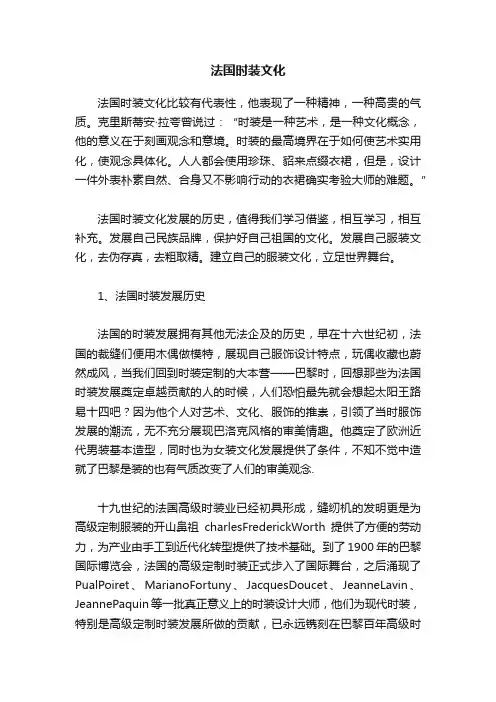
法国时装文化法国时装文化比较有代表性,他表现了一种精神,一种高贵的气质。
克里斯蒂安·拉夸曾说过:“时装是一种艺术,是一种文化概念,他的意义在于刻画观念和意境。
时装的最高境界在于如何使艺术实用化,使观念具体化。
人人都会使用珍珠、貂来点缀衣裙,但是,设计一件外表朴素自然、合身又不影响行动的衣裙确实考验大师的难题。
”法国时装文化发展的历史,值得我们学习借鉴,相互学习,相互补充。
发展自己民族品牌,保护好自己祖国的文化。
发展自己服装文化,去伪存真,去粗取精。
建立自己的服装文化,立足世界舞台。
1、法国时装发展历史法国的时装发展拥有其他无法企及的历史,早在十六世纪初,法国的裁缝们便用木偶做模特,展现自己服饰设计特点,玩偶收藏也蔚然成风,当我们回到时装定制的大本营——巴黎时,回想那些为法国时装发展奠定卓越贡献的人的时候,人们恐怕最先就会想起太阳王路易十四吧?因为他个人对艺术、文化、服饰的推崇,引领了当时服饰发展的潮流,无不充分展现巴洛克风格的审美情趣。
他奠定了欧洲近代男装基本造型,同时也为女装文化发展提供了条件,不知不觉中造就了巴黎是装的也有气质改变了人们的审美观念.十九世纪的法国高级时装业已经初具形成,缝纫机的发明更是为高级定制服装的开山鼻祖charlesFrederickWorth提供了方便的劳动力,为产业由手工到近代化转型提供了技术基础。
到了1900年的巴黎国际博览会,法国的高级定制时装正式步入了国际舞台,之后涌现了PualPoiret、MarianoFortuny、JacquesDoucet、JeanneLavin、JeannePaquin等一批真正意义上的时装设计大师,他们为现代时装,特别是高级定制时装发展所做的贡献,已永远镌刻在巴黎百年高级时装的发展史中,其中一些人所创立的个人品牌,至今仍为世人所熟知2、法国时装文化品牌与精神法国高级时装发展时间长,品牌繁多,在世界上拥有极高的地位,经过百年多的发展,赋予了他们特殊的精神。
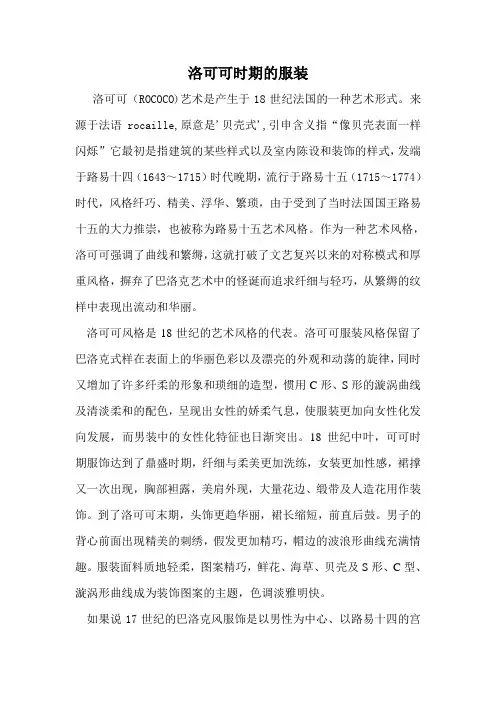
洛可可时期的服装洛可可(ROCOCO)艺术是产生于18世纪法国的一种艺术形式。
来源于法语rocaille,原意是'贝壳式',引申含义指“像贝壳表面一样闪烁”它最初是指建筑的某些样式以及室内陈设和装饰的样式,发端于路易十四(1643~1715)时代晚期,流行于路易十五(1715~1774)时代,风格纤巧、精美、浮华、繁琐,由于受到了当时法国国王路易十五的大力推崇,也被称为路易十五艺术风格。
作为一种艺术风格,洛可可强调了曲线和繁缛,这就打破了文艺复兴以来的对称模式和厚重风格,摒弃了巴洛克艺术中的怪诞而追求纤细与轻巧,从繁缛的纹样中表现出流动和华丽。
洛可可风格是18世纪的艺术风格的代表。
洛可可服装风格保留了巴洛克式样在表面上的华丽色彩以及漂亮的外观和动荡的旋律,同时又增加了许多纤柔的形象和琐细的造型,惯用C形、S形的漩涡曲线及清淡柔和的配色,呈现出女性的娇柔气息,使服装更加向女性化发向发展,而男装中的女性化特征也日渐突出。
18世纪中叶,可可时期服饰达到了鼎盛时期,纤细与柔美更加洗练,女装更加性感,裙撑又一次出现,胸部袒露,美肩外现,大量花边、缎带及人造花用作装饰。
到了洛可可末期,头饰更趋华丽,裙长缩短,前直后鼓。
男子的背心前面出现精美的刺绣,假发更加精巧,帽边的波浪形曲线充满情趣。
服装面料质地轻柔,图案精巧,鲜花、海草、贝壳及S形、C型、漩涡形曲线成为装饰图案的主题,色调淡雅明快。
如果说17世纪的巴洛克风服饰是以男性为中心、以路易十四的宫廷为舞台展开的奇特装束,与此相对,18世纪的洛可可风服饰则是继巴洛克艺术风格之后,发源于法国并很快遍及欧洲的一种以女性为中心,以沙龙为舞台展开的优雅样式。
洛可可艺术的繁琐风格和中国清代艺术相类似,是中西封建历史即将结束的共同征兆。
一、女装(图1)初期当时流一种称为“响亮的长袍”的室内服,背部有褶皱,呈又宽又长的托裙形式,又叫罗布●吾奥朗特(robe volante)。

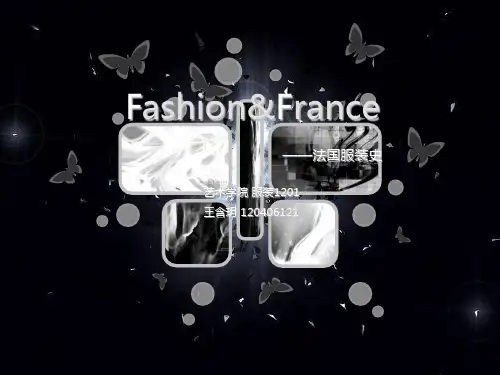
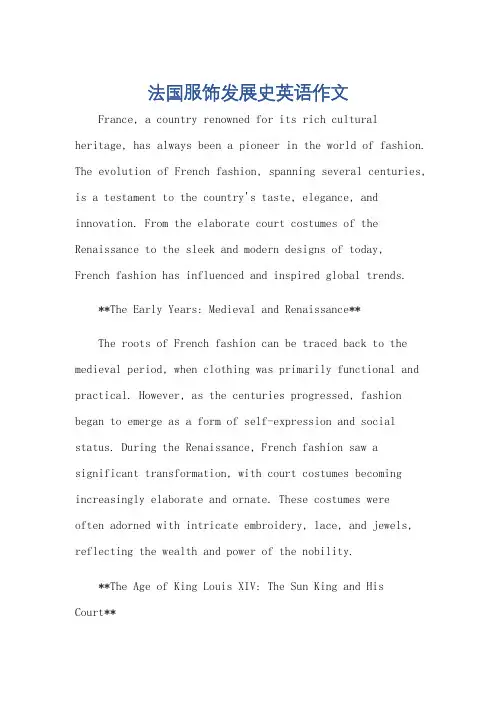
法国服饰发展史英语作文France, a country renowned for its rich cultural heritage, has always been a pioneer in the world of fashion. The evolution of French fashion, spanning several centuries, is a testament to the country's taste, elegance, and innovation. From the elaborate court costumes of the Renaissance to the sleek and modern designs of today,French fashion has influenced and inspired global trends.**The Early Years: Medieval and Renaissance**The roots of French fashion can be traced back to the medieval period, when clothing was primarily functional and practical. However, as the centuries progressed, fashion began to emerge as a form of self-expression and social status. During the Renaissance, French fashion saw a significant transformation, with court costumes becoming increasingly elaborate and ornate. These costumes wereoften adorned with intricate embroidery, lace, and jewels, reflecting the wealth and power of the nobility.**The Age of King Louis XIV: The Sun King and HisCourt**The 17th century marked a pivotal moment in French fashion history, with the reign of King Louis XIV, known as the Sun King. This era saw the emergence of a highly stylized and formalized fashion code, known as the "Louis XIV style." The king's court was a hotbed of fashion activity, with designers and tailors competing to create the most extravagant and extravagant costumes. These costumes were characterized by their opulence and grandeur, with elaborate embroidery, lavish fabrics, and intricate details. The fashion of this period set the tone for French fashion for centuries to come.**The Age of Enlightenment: Simplicity andRationality**The 18th century brought about a shift in French fashion, with the rise of the Enlightenment movement. This period emphasized rationality and simplicity, leading to a more toned-down and practical approach to fashion. Women's fashion moved towards a more natural and elegant look, with simpler lines and fewer embellishments. The popularization of the corset and the emphasis on a slim, curvy figure also became a hallmark of this period.**The Romantic Era: Emotion and Extravagance**The 19th century saw a return to extravagance and emotion in French fashion. The Romantic era emphasizedfree-flowing lines, delicate fabrics, and intricate details. Women's fashion moved towards a more romantic and feminine look, with Empire-line dresses and lavish gowns becoming popular. The influence of foreign styles, particularly from Byzantium and the Middle East, also made their way into French fashion, adding a unique and exotic touch.**The 20th Century: Evolution and Revolution**The 20th century was a period of significant change and innovation in French fashion. The early decades saw the emergence of new designers and fashion houses, such as Gabrielle Chanel and Coco Chanel, who revolutionizedwomen's fashion with their innovative and practical designs. These designers emphasized comfort and functionality, while still maintaining a sense of elegance and sophistication.The 1960s and 1970s marked a further evolution inFrench fashion, with the emergence of the "Nouveau Couture" movement. This movement advocated for a more relaxed and informal approach to fashion, emphasizing individuality andfreedom. Designers such as Yves Saint Laurent and Pierre Cardin revolutionized the fashion industry with their bold and experimental designs, blending traditional French elegance with modern and futuristic elements.**Conclusion**The evolution of French fashion is a fascinating journey through history, reflecting the changing tastes, values, and social landscapes of the country. From the elaborate court costumes of the Renaissance to the sleek and modern designs of today, French fashion has always been a forerunner in the world of fashion, influencing and inspiring global trends. As we look towards the future, it remains to be seen what new innovations and directions French fashion will take, but one thing is certain: it will continue to be a source of inspiration and influence for fashion lovers worldwide.**法国服饰发展史的演变:一段历史之旅**法国,这个以丰富的文化遗产而闻名的国家,一直是时尚界的先驱。
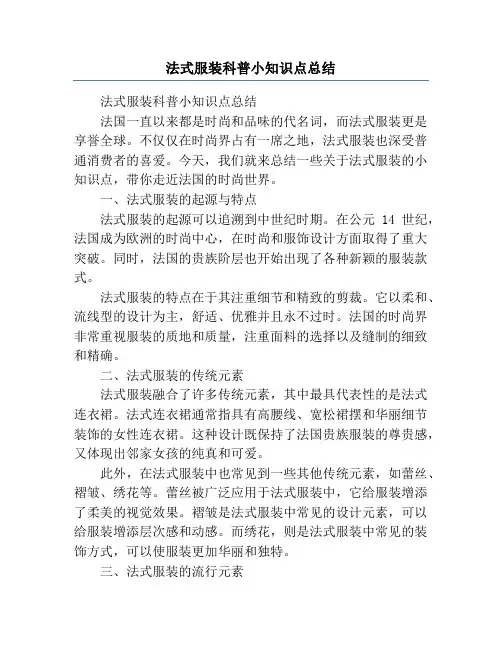
法式服装科普小知识点总结法式服装科普小知识点总结法国一直以来都是时尚和品味的代名词,而法式服装更是享誉全球。
不仅仅在时尚界占有一席之地,法式服装也深受普通消费者的喜爱。
今天,我们就来总结一些关于法式服装的小知识点,带你走近法国的时尚世界。
一、法式服装的起源与特点法式服装的起源可以追溯到中世纪时期。
在公元14世纪,法国成为欧洲的时尚中心,在时尚和服饰设计方面取得了重大突破。
同时,法国的贵族阶层也开始出现了各种新颖的服装款式。
法式服装的特点在于其注重细节和精致的剪裁。
它以柔和、流线型的设计为主,舒适、优雅并且永不过时。
法国的时尚界非常重视服装的质地和质量,注重面料的选择以及缝制的细致和精确。
二、法式服装的传统元素法式服装融合了许多传统元素,其中最具代表性的是法式连衣裙。
法式连衣裙通常指具有高腰线、宽松裙摆和华丽细节装饰的女性连衣裙。
这种设计既保持了法国贵族服装的尊贵感,又体现出邻家女孩的纯真和可爱。
此外,在法式服装中也常见到一些其他传统元素,如蕾丝、褶皱、绣花等。
蕾丝被广泛应用于法式服装中,它给服装增添了柔美的视觉效果。
褶皱是法式服装中常见的设计元素,可以给服装增添层次感和动感。
而绣花,则是法式服装中常见的装饰方式,可以使服装更加华丽和独特。
三、法式服装的流行元素时尚界一直在不断变化,并且随着时间的推移,法式服装也随之发展。
现在,许多流行元素已经融入到法式服装中,使其更加时尚和多变。
一种常见的流行元素是拼接设计。
拼接设计在法式服装中表现得尤为突出,不同材质和花色的面料可以通过拼接的方式制成一件完整的服装。
这种设计方式既能展示设计师的创意和技巧,又能打破传统的束缚,使服装更具个性和时尚感。
此外,一些时尚标志性的元素也被广泛运用于法式服装中。
例如,条纹图案是法式服装中非常经典的元素之一,尤其是黑白条纹。
此外,蝴蝶结、蓬松的袖子和腰间的腰带也常常可以在法式服装中看到。
四、如何搭配法式服装法式服装擅长的是将优雅与时尚结合,因此搭配法式服装时要注重整体的搭配效果。


法国服装历史
法国服装历史可以追溯到中世纪时期。
在此期间,欧洲的贵族和富商们喜欢穿着华丽、奢侈的服装来展示自己的地位和身份。
贵族们常穿绣满精美金线的长袍和各种颜色的披风。
到了文艺复兴时期,法国服装开始进入现代化阶段。
法国的“人类天才”达芬奇在意大利发现了画面的透视性和人体比例的原理,并将这些原理引入到服装设计中。
随着经济的发展,法国纺织业和制衣业也逐渐崛起,同时,随着路易十四的崛起和宫廷文化的兴盛,法国的时尚成为了欧洲的引领者。
18世纪末,法国大革命对时尚有着深远的影响。
自由、平等、博爱的宣传口号影响了服装的设计和制作,裤管变短,腰带被取消,领子变小等等。
此外,19世纪初期,法国的新皇帝拿破仑成为了时尚潮流的倡导者,他提倡男性穿着紧身衣、高领袍和大马褂等服装。
到了19世纪后期,法国时尚被视为全球时尚的引领者。
设计师们开始使用各种不同的材料如蕾丝、玻璃纱和丝绸等,制作出女性庞克风、复古风和芭比娃娃风等各种各样的时装。
同时,法国的高级服装定制业也非常发达,许多高端定制品牌如香奈儿、迪奥、拉奎尔等都在法国诞生。
20世纪以来,随着战争、社会变革和经济增长的影响,法国的时装设计也发生了很大的变化。
1950年代,爵士乐和摇滚乐的影响带来了男性剪裁户外服装和运动服装的流行。
1980年代,时尚设计师们使用更多的尼龙和合成材料,推出了一系列色彩鲜艳、轻便舒适的新款式。
今天,法国时装设计仍然保持着其高水准和创意,是全球时尚潮流的重要参考。
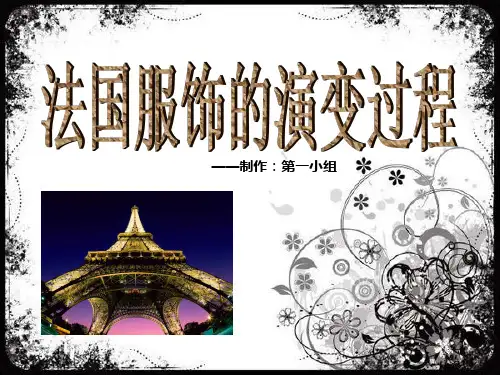
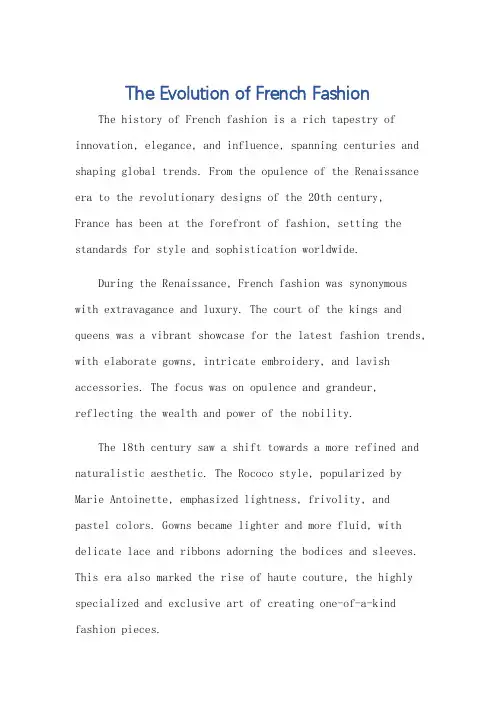
The Evolution of French FashionThe history of French fashion is a rich tapestry of innovation, elegance, and influence, spanning centuries and shaping global trends. From the opulence of the Renaissance era to the revolutionary designs of the 20th century,France has been at the forefront of fashion, setting the standards for style and sophistication worldwide.During the Renaissance, French fashion was synonymous with extravagance and luxury. The court of the kings and queens was a vibrant showcase for the latest fashion trends, with elaborate gowns, intricate embroidery, and lavish accessories. The focus was on opulence and grandeur, reflecting the wealth and power of the nobility.The 18th century saw a shift towards a more refined and naturalistic aesthetic. The Rococo style, popularized by Marie Antoinette, emphasized lightness, frivolity, andpastel colors. Gowns became lighter and more fluid, with delicate lace and ribbons adorning the bodices and sleeves. This era also marked the rise of haute couture, the highly specialized and exclusive art of creating one-of-a-kind fashion pieces.The Industrial Revolution in the 19th century brought about significant changes in the fashion industry. With the advent of machines and factories, clothing became more accessible and affordable for the masses. However, French fashion maintained its elitist status, with haute couture houses like Chanel and Dior continuing to create luxurious and exclusive designs.The 20th century was a time of revolution and experimentation in French fashion. Designers like Coco Chanel and Yves Saint Laurent broke away from traditional constraints, introducing modern and feminine designs that emphasized simplicity, comfort, and elegance. Chanel'slittle black dress and Saint Laurent's Le Smoking suit became icons of timeless style.The post-war era saw a renewed interest in fashion, with Paris once again emerging as the capital of global fashion. Designers like Pierre Cardin and Emanuel Ungaro pushed the boundaries of creativity, incorporating new materials, cuts, and patterns into their designs.In the modern era, French fashion continues to be a global force, with designers like Karl Lagerfeld, Jean PaulGaultier, and Hedi Slimane leading the way. Their designs are a blend of tradition and innovation, reflecting therich heritage of French fashion while pushing theboundaries of creativity and style.The influence of French fashion extends beyond the catwalk and the haute couture houses. It has shaped popular culture, influenced fashion trends across the globe, and inspired countless designers and fashion enthusiasts. The elegance, sophistication, and creativity of French fashion continue to captivate and inspire, making it an enduringand influential part of human history.**法国服饰发展史**法国服饰发展史是一部融合了创新、优雅与影响力的丰富画卷,跨越数个世纪,塑造着全球潮流。

法国服饰发展史哎呀,说起法国服饰发展史,那可真是一部活生生的时尚大片啊!咱们今天就聊聊这个,权当是午后茶歇时的小八卦,轻松一下。
记得前年去巴黎旅游,那叫一个浪漫啊!走在香榭丽舍大街上,满眼都是时尚达人,穿得那叫一个花枝招展,看得我眼花缭乱。
当时我就在想,这些衣服背后的故事,得有多精彩呢?于是,回来后我就特意查了查,这一查,嘿,还真让我发现了不少好玩的事儿。
咱们先说说古代吧,那时候的法国服饰,简直就是贵族们的炫耀大会。
就拿那宫廷装来说吧,男的穿的是紧身衣配长裤,上面还绣着金线银线,走起路来那叫一个摇曳生姿,跟现在的男模走秀似的。
女的呢,就更讲究了,层层叠叠的裙子,上面还镶着珍珠宝石,走起路来裙摆飘飘,简直就像仙女下凡。
不过啊,这些衣服虽然好看,但穿起来可受罪了,听说那些贵族小姐们为了保持身材,还得穿束腰,那滋味,想想都难受。
到了中世纪,服饰风格就开始变得有点“重口味”了。
那时候的人们,特别喜欢繁复的装饰,衣服上到处都是蕾丝、褶皱,看得人眼花缭乱。
特别是男士的帽子,那叫一个夸张,高高的,上面还装饰着羽毛,走在大街上,简直就是移动的风景线。
女士们呢,则是各种蓬蓬裙、泡泡袖,看起来就像是从童话里走出来的公主。
不过啊,这些衣服虽然华丽,但洗起来可麻烦了,得请专门的洗衣工,用特殊的方法才能洗干净。
到了近现代,法国服饰就开始走简约风了。
特别是到了20世纪,随着女性地位的提高,服饰也开始变得更加实用、舒适。
像香奈儿、迪奥这些大品牌,就开始倡导“简约而不简单”的设计理念,把优雅和实用完美地结合在了一起。
我记得在巴黎的一家博物馆里,还看到过一件香奈儿的经典小黑裙,那叫一个简洁大方,穿在身上,气质立马就提升了好几个档次。
不过啊,最让我印象深刻的,还是法国人的配饰文化。
不管是项链、耳环,还是手套、帽子,他们都能搭配得恰到好处,让人眼前一亮。
特别是巴黎的街头巷尾,那些小店里卖的饰品,虽然不贵,但设计得特别有味道,买上一两件,就能让整个人的气质都提升不少。